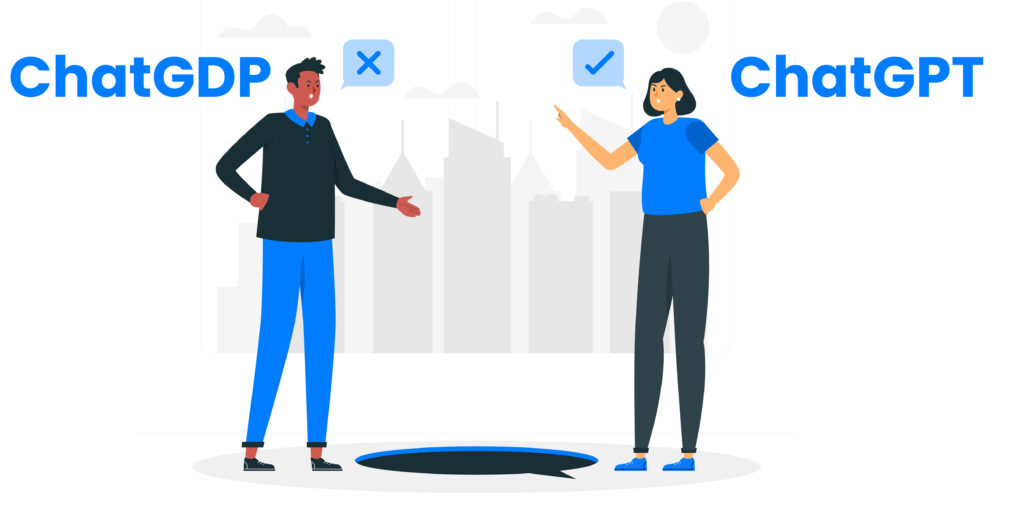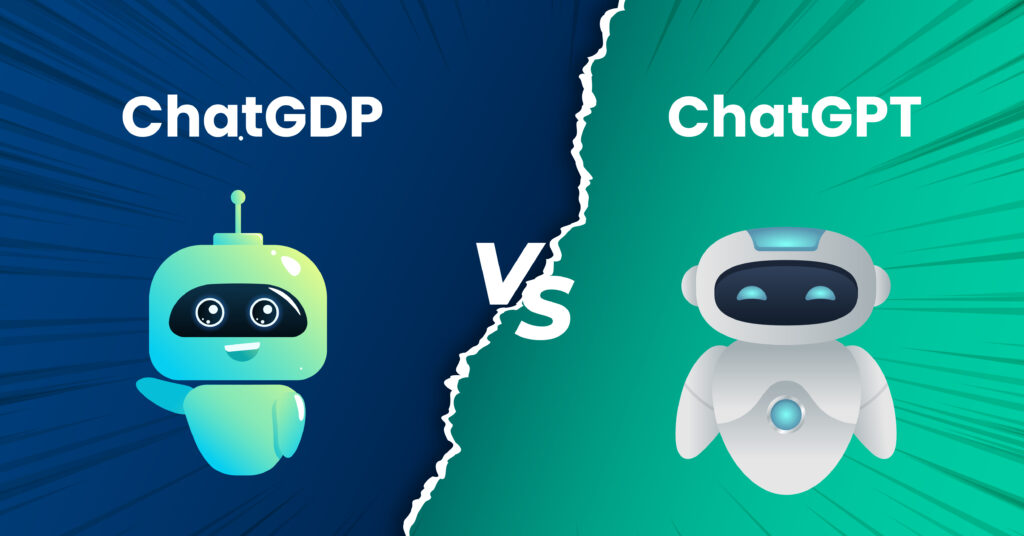AI terminology can often be misunderstood and confusing in today’s dynamic AI landscape, such as between “ChatGPT” and “ChatGDP” which have often caused confusion. OpenAI developed ChatGPT while “ChatGDP” is considered incorrect spelling of that name. ChatGPT, with its advanced conversational abilities and GPT-3.5/GPT-4 model capabilities has revolutionized artificial intelligence since it first made its debut on November 30th 2022. Read here about this remarkable AI breakthrough! This article covers one of ChatGPT’s true advantages as a revolutionary solution! It also seeks to explain the mysterious term, ChatGDP.” ChatGPT, projected to reach 100 millions users by January 2023 has generated widespread curiosity and confusion, thus leading to its creation – hence this guide’s aim of dispelling myths surrounding ChatGDP while explaining its functionality.
Table of Contents
ToggleWhat is ChatGPT?
ChatGPT was developed and distributed by OpenAI in 2022 using Generative Pretrained Transformers as an iconic achievement of artificial intelligence. Remarkably fast in responding accurately and rapidly, ChatGPT stands as an industry standard when it comes to understanding user inquiries quickly and providing answers quickly and precisely.
ChatGPT combines both supervised learning and reinforcement-learning technologies for improved capacity to learn large amounts of data quickly, and process it effectively. After rigorous training sessions AI models can engage in context-sensitive dialogues on various subjects or languages with ease.
ChatGPT will have made an incredible impactful statement of global influence with over 100 millions users by January 2023, which underscores its versatility and effectiveness across various applications such as content production, customer service and education. Other tech giants increased AI research due to ChatGPT’s human-like conversations which made an immediate impression in people. It serves as an impressive demonstration of AI becoming more integrated into daily lives and work environments alike.
The Misconception of ChatGDP

One classic case of this can be seen with the common mispellings between “ChatGDP” and “ChatGPT” within technology circles, leading to confusion. While both names sound similar and information spreads rapidly across platforms like social media channels; their distinction can become easily misconstrued due to similar names being similar enough that confusion between them arises naturally.
As users mistyped the name when searching for information about OpenAI’s ChatGPT, the term “ChatGDP” gained traction. Misinformation propagates easily online, especially with terms associated with cutting-edge technology. The term “ChatGDP” frequently appears in searches and discussions online, but none of the AI models or technologies named ChatGDP were developed by OpenAI or any other recognized tech organization.
An individual created a website with this name as a result of the rise in the usage of “ChatGDP”. Tech enthusiasts need to understand that this website does not represent or relate to the official ChatGPT AI model by OpenAI. It is crucial to understand this distinction in navigating the digital landscape and obtaining accurate AI information.
The importance of staying informed and discerning about the technologies we interact with and discuss grows as AI evolves and becomes more ingrained in our daily lives. Tech innovation is characterized by speed and complexity. The case of “ChatGDP” illustrates this.
Why "ChatGPT" Appears in Searches for "ChatGDP"
It is primarily the algorithms and features of modern search engines that cause results for “ChatGDP” to appear for ChatGPT. Even when faced with misspellings or inaccuracies in queries, these sophisticated systems provide the most relevant and accurate information. Even when you type “ChatGDP”, you always see ChatGPT in your search results:
- Algorithms for Detection & Correction: Search engines automatically detect and correct misspellings. Search engines will adjust their results automatically when they recognize “ChatGDP”, as a misspelling or typo of “ChatGPT”, which is more relevant and popular.
- Search Query Optimization: Using common and popular queries, search engines optimize results. The search engine prioritizes ChatGPT over the less known or non-existent term “ChatGDP” because it is widely recognized and discussed.
- A feedback loop: User interactions continuously teach search engines. The algorithm assumes ChatGPT is the relevant result for similar queries if most users who search for “ChatGDP” engage with content related to ChatGPT. As a result, ChatGPT appears more prominently in related searches.
- Semantic Search Capabilities: The search engines of today use semantic search technology, which understands the intention behind a query. Based on context and popularity of ChatGPT, the search engine interprets “ChatGDP” as an intent, leading to results related to ChatGPT.
- Search Results for ChatGDP: Currently, there are no authoritative sources or relevant websites for “ChatGDP” since it is not an established technology or product. Therefore, search engines default to ChatGPT in this case, which is the closest match.
ChatGPT's Mechanism and Applications
With ChatGPT, OpenAI revolutionized conversational AI. A language model is used to understand and generate human-like text using GPT (Generative Pre-trained Transformer). An important component of this mechanism is human feedback.
Mechanism:
- Supervised Learning: Several internet texts are used in ChatGPT training. Throughout the training, the model learns to understand and respond to a variety of topics. Learning from examples, where the desired responses are already known, is called supervised learning.
- Reinforcement Learning: Reinforcement learning refines ChatGPT after initial training. To understand which types of responses are more effective, humans rank the model’s responses to different prompts.
Applications:
With ChatGPT, you can do much more than just talk. This versatility and utility are demonstrated by its many applications:
- ChatGPT: ChatGPT automates customer service by providing instantaneous, accurate and conversational answers.
- Content creation: streamlines the creative process. Writers and content creators can use ChatGPT for ideas and to draft articles.
- Education chatGPT offers tutoring and homework help in education.
- Programming Assistance: During the software development process, ChatGPT is valuable for writing, debugging, and understanding code.
- Entertainment: ChatGPT is exploring its creative abilities in the entertainment industry, from composing music to writing stories.
- Business Analytics: Insights for business decision-making are provided by ChatGPT by analyzing and interpreting large datasets.
- Language Translation: ChatGPT enables cross-cultural communication with its deep learning capabilities.
The Curiosity Behind ChatGDP
The term “ChatGDP” is an interesting phenomenon that has emerged in the world of modern technology. It is actually a misspelling for OpenAI’s ChatGPT.
- ChatGPT Knows Its Name: ChatGPT’s rapid rise and widespread popularity can also lead to unintentional misspellings, such as “ChatGDP,” resulting in increased interest and engagement. In the digital age, brands and products can quickly become household names, leading to variations in their names.
- Search Engine Dynamics: Intricacies of search engine algorithms and user behavior lead to confusion between ChatGPT and ChatGDP. In response, search engines provide relevant results based on the term “ChatGDP” when people search for information about ChatGPT. As a result of this adaptability, misspellings persist.
- Opportunistic Digital Ventures: By naming the website “ChatGDP,” we capitalize on a common typo. A simple spelling error can open up opportunities for digital entrepreneurs and web developers based on trending topics or common search engine queries.
- Information and Misinformation: Keeping accurate information in the digital age is challenging in the case of ChatGDP versus ChatGPT. Especially when dealing with cutting-edge technologies such as AI, it illustrates how quickly misinformation can spread.
- Impacts on AI Development: A growing interest in AI technologies is also reflected in “ChatGDP”. Although people’s understanding and spelling of AI may not be accurate, it indicates a broader trend to learn about and engage with AI.
Conclusion
“ChatGDP” evolved into ChatGPT through the fascinating interplay between language, technology, and user behavior in the digital age. Despite being a misspelling, “ChatGDP” highlights the wide recognition and impact of ChatGPT, OpenAI’s advanced AI chatbot. Our rapidly evolving tech landscape demands accurate information and understanding. Adaptability and being well-informed in the face of new developments are crucial as AI continues to shape our world. This success story highlights the dynamic nature of technology and its terminology as well as ChatGPT’s accomplishments in AI.

My name is Robert James, and I have over a decade of experience in digital marketing and technology innovation. I have contributed to numerous successful campaigns and advancements in artificial intelligence marketing. With a focus on AI, I hold a Master’s degree in Computer Science. I am sought after by tech forums and publications. I explore and demystify the evolving landscape of AI in marketing by sharing my knowledge.


